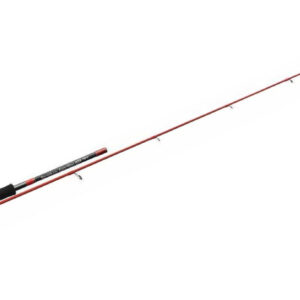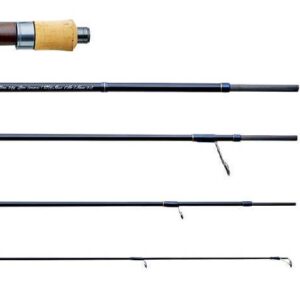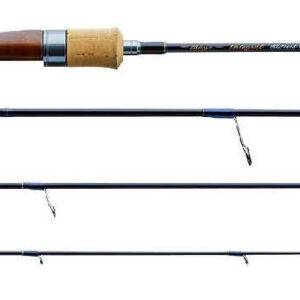Predator Lure Rods
Predator fishing requires a specific type of rod that is designed to handle the weight and action of the lures being used. Lure rods for predator fishing come in different lengths, weights, and actions, and it is important to choose the right one for the type of fishing that you will be doing. In this article, we will discuss the different types of predator lure rods and their suitability for predator fishing.
Spinning Rods
Spinning rods are the most popular type of predator lure rod. They are versatile and easy to use, making them popular with novice and experienced anglers alike. Spinning rods come in a range of lengths and powers and are designed with a fast action that is ideal for casting lures and retrieving them at speed.
Key features of spinning rods include:
– Lightweight design: Spinning rods are made from lightweight materials, making them easy to handle and control.
– Fast action: Spinning rods have a fast action that is highly responsive to even the slightest movement.
– Shorter length: Most spinning rods are relatively short, usually ranging from 6 to 8 feet in length. This makes them suitable for fishing in tight spaces such as rivers and streams.
– Line weight: Spinning rods are generally designed to handle lighter line weights, making them ideal for targeting smaller predators such as perch and chub.
Casting Rods
Casting rods, also known as baitcasting rods, are another popular type of predator lure rod. They are designed to handle heavier line weights and larger lures, making them ideal for targeting bigger predators such as pike and zander.
Key features of casting rods include:
– Heavy-duty construction: Casting rods are built to handle heavier line weights and larger lures, so they tend to be thicker and sturdier than spinning rods.
– Longer length: Casting rods are generally longer than spinning rods and range from 7 to 10 feet in length. This gives them more casting distance and makes them more suitable for open-water fishing.
– Slow action: Casting rods have a slower action than spinning rods, which means they can handle heavier loads.
– Baitcasting reel: Casting rods are designed to be used with baitcasting reels, which allow for greater accuracy and control when casting heavier lures.
Telescopic Rods
Telescopic rods are a relatively new addition to the predator fishing scene, but they are rapidly gaining popularity. These rods are designed to collapse down into a compact size, making them easy to transport and store.
Key features of telescopic rods include:
– Collapsible design: Telescopic rods can be collapsed down to a small size, making them ideal for travel and storage.
– Flexible length: Telescopic rods can be extended to different lengths, ranging from 6 to 12 feet. This gives anglers the flexibility to adjust their rod length depending on their fishing conditions.
– Fast action: Telescopic rods have a similar action to spinning rods, which makes them ideal for casting and retrieving lures.
– Lightweight: Telescopic rods are lightweight and easy to handle, making them suitable for both novice and experienced anglers.
Materials
The material used to make a predator lure rod is important in determining its performance. There are three main materials used in rod construction:
– Carbon Fiber: Carbon fiber is a popular material as it is lightweight, strong, and sensitive. Carbon fiber rods tend to be more expensive than other materials, but they are also more durable and long-lasting.
– Fiberglass: Fiberglass is a more affordable option for predator lure rods. It is heavier and less sensitive than carbon fiber, but it is also more flexible and durable.
– Composite: Composite rods are the perfect blend of carbon fiber and fiberglass, which allows for a good balance of strength, sensitivity, and flexibility.
Action
The action of a rod refers to how much it bends when pressure is applied to it. There are three main types of rod action:
– Fast action: Fast action rods are highly sensitive and responsive, making them ideal for casting and retrieving lures.
– Medium action: Medium action rods have a more flexible tip, which makes them ideal for fishing in situations where a slower, more controlled presentation is needed.
– Slow action: Slow action rods have a very flexible tip, which makes them the best choice for fishing in shallow water or when the predator is close to the surface.
Length
The length of a predator lure rod is important when selecting the right rod. The length will affect its casting distance, sensitivity, and ability to handle different fishing conditions.
– Short rods: Short predator lure rods, ranging from around 6 to 7 feet in length, are ideal for fishing in tight spaces such as rivers and streams. They are also suitable for targeting smaller predators such as perch and chub.
– Medium rods: Medium predator lure rods, ranging from around 7 to 9 feet in length, are a good option for open-water fishing. They are versatile and can be used to target a variety of different predators.
– Long rods: Long predator lure rods, ranging from around 9 to 12 feet in length, are ideal for fishing in big open waters such as large lakes or reservoirs. They can cast further and allow anglers to cover more water.
Conclusion
Predator fishing requires a specific type of rod designed to handle the weight and action of lures. Spinning rods, casting rods, and telescopic rods are all popular types of predator lure rods, each with its own advantages and disadvantages. When selecting a predator lure rod, it is important to consider the material, action, length, and line weight, as well as personal preferences and the type of predator fishing that will be done. With the right predator lure rod, anglers can increase their chances for a successful fishing trip.
-

Tenryu Injection SPV6.5MH 6’5″ 10-40g 1+1pc
£751.79 -

Tenryu Injection SP82ML 8’2″ 5-20g 1+1pcs
£751.79 -

Tenryu Injection SP82MH LC Black Limited 8’2″ 12-45g 1+1pcs
£932.39 -

Tenryu Injection SP82M 2ES Injection 8’2″ 8-30g 2pcs
£791.99 -

Tenryu Injection SP80M 2ES Minnow 8′ 10-28g 2pcs
£791.99 -

Tenryu Injection SP79MH Black Limited 7’9″ 8-35g 1+1pc
£902.39 -

Tenryu Injection SP78H 7’8″ 15-60g 1+1pc
£771.59 -

Tenryu Rayz Spectra RZS61LL 6’1″ 1-8g 2pcs
£926.99 -

Tenryu Rayz Integral RZI845S-MH 8’4″ Up to 25g 5pcs
£1,052.39 -

Tenryu Rayz Integral RZI755S-MLM 7’5″ Up to 20g 5pcs
£993.59 -

Tenryu Rayz Integral RZI484S-UL 4’8″ Up to 6g 4pcs
£817.79 -

Tenryu Rayz Integral RZI484S-L 4’8″ Up to 8g 4pcs
£827.99
Predator fishing requires a specific type of rod that is designed to handle the weight and action of the lures being used. Lure rods for predator fishing come in different lengths, weights, and actions, and it is important to choose the right one for the type of fishing that you will be doing. In this article, we will discuss the different types of predator lure rods and their suitability for predator fishing.
Spinning Rods
Spinning rods are the most popular type of predator lure rod. They are versatile and easy to use, making them popular with novice and experienced anglers alike. Spinning rods come in a range of lengths and powers and are designed with a fast action that is ideal for casting lures and retrieving them at speed.
Key features of spinning rods include:
– Lightweight design: Spinning rods are made from lightweight materials, making them easy to handle and control.
– Fast action: Spinning rods have a fast action that is highly responsive to even the slightest movement.
– Shorter length: Most spinning rods are relatively short, usually ranging from 6 to 8 feet in length. This makes them suitable for fishing in tight spaces such as rivers and streams.
– Line weight: Spinning rods are generally designed to handle lighter line weights, making them ideal for targeting smaller predators such as perch and chub.
Casting Rods
Casting rods, also known as baitcasting rods, are another popular type of predator lure rod. They are designed to handle heavier line weights and larger lures, making them ideal for targeting bigger predators such as pike and zander.
Key features of casting rods include:
– Heavy-duty construction: Casting rods are built to handle heavier line weights and larger lures, so they tend to be thicker and sturdier than spinning rods.
– Longer length: Casting rods are generally longer than spinning rods and range from 7 to 10 feet in length. This gives them more casting distance and makes them more suitable for open-water fishing.
– Slow action: Casting rods have a slower action than spinning rods, which means they can handle heavier loads.
– Baitcasting reel: Casting rods are designed to be used with baitcasting reels, which allow for greater accuracy and control when casting heavier lures.
Telescopic Rods
Telescopic rods are a relatively new addition to the predator fishing scene, but they are rapidly gaining popularity. These rods are designed to collapse down into a compact size, making them easy to transport and store.
Key features of telescopic rods include:
– Collapsible design: Telescopic rods can be collapsed down to a small size, making them ideal for travel and storage.
– Flexible length: Telescopic rods can be extended to different lengths, ranging from 6 to 12 feet. This gives anglers the flexibility to adjust their rod length depending on their fishing conditions.
– Fast action: Telescopic rods have a similar action to spinning rods, which makes them ideal for casting and retrieving lures.
– Lightweight: Telescopic rods are lightweight and easy to handle, making them suitable for both novice and experienced anglers.
Materials
The material used to make a predator lure rod is important in determining its performance. There are three main materials used in rod construction:
– Carbon Fiber: Carbon fiber is a popular material as it is lightweight, strong, and sensitive. Carbon fiber rods tend to be more expensive than other materials, but they are also more durable and long-lasting.
– Fiberglass: Fiberglass is a more affordable option for predator lure rods. It is heavier and less sensitive than carbon fiber, but it is also more flexible and durable.
– Composite: Composite rods are the perfect blend of carbon fiber and fiberglass, which allows for a good balance of strength, sensitivity, and flexibility.
Action
The action of a rod refers to how much it bends when pressure is applied to it. There are three main types of rod action:
– Fast action: Fast action rods are highly sensitive and responsive, making them ideal for casting and retrieving lures.
– Medium action: Medium action rods have a more flexible tip, which makes them ideal for fishing in situations where a slower, more controlled presentation is needed.
– Slow action: Slow action rods have a very flexible tip, which makes them the best choice for fishing in shallow water or when the predator is close to the surface.
Length
The length of a predator lure rod is important when selecting the right rod. The length will affect its casting distance, sensitivity, and ability to handle different fishing conditions.
– Short rods: Short predator lure rods, ranging from around 6 to 7 feet in length, are ideal for fishing in tight spaces such as rivers and streams. They are also suitable for targeting smaller predators such as perch and chub.
– Medium rods: Medium predator lure rods, ranging from around 7 to 9 feet in length, are a good option for open-water fishing. They are versatile and can be used to target a variety of different predators.
– Long rods: Long predator lure rods, ranging from around 9 to 12 feet in length, are ideal for fishing in big open waters such as large lakes or reservoirs. They can cast further and allow anglers to cover more water.
Conclusion
Predator fishing requires a specific type of rod designed to handle the weight and action of lures. Spinning rods, casting rods, and telescopic rods are all popular types of predator lure rods, each with its own advantages and disadvantages. When selecting a predator lure rod, it is important to consider the material, action, length, and line weight, as well as personal preferences and the type of predator fishing that will be done. With the right predator lure rod, anglers can increase their chances for a successful fishing trip.
100% Original product that covered warranty by the vendor.
You have the right to return your orders within 30 days.
Your orders are shipped seamlessly between countries.
Your payments are secure with our private security network.
